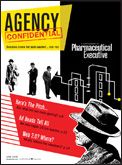Building Online Community
Web site supports Crohn's patients and supplies goal-busting database for company's new product
When Ally Bain, a teenager with Crohn's disease, was denied access to a restroom in a Chicago clothing store (even with a card detailing her medical condition), she had an accident. She also vowed to prevent others from having to go through such pain and humiliation. She took her cause to the Illinois state legislature, which passed "Ally's Law," giving people with debilitating intestinal disorders access to any business restroom.

Ally told a powerful story for an underserved population, the right people listened, and the results were substantial. Her story garnered an even wider audience on crohnsandme.com, a Web 2.0 site developed by Heartbeat Digital and sponsored by UCB Group.
Initially launched as an unbranded site, it now highlights information on UCB's Cimzia (certolizumab pegol), a biologic that received FDA approval in April for adults with moderate to severe Crohn's disease who have not responded to conventional therapies.
Crohn's disease is a chronic, inflammatory bowel disease that affects more than one million men and women worldwide.
A win/win situation
The marketing challenge was to deliver a 2.0 Web site, crohnsandme.com, that offered community and supplied patients with goals for living a normal life. The Web site includes videos of Ally Bain and other Crohn's patients (and their doctors and family members) telling their stories about surviving, and even thriving, with the condition. It also includes information on the 50-state advocacy program created by the agency to spread the word.
For the client, UCB Group, the challenge was to build an initially unbranded Web site that would yield a significant database of highly qualified patients. The database and the Web site could then be used to communicate with patients about the company's new treatment option. The secondary goal was to introduce UCB Group, with headquarters in Brussels, to US patients, and to position them as a patient-centric company.
Database acquisition goals for the first year were met two months after the site's launch. Currently, the number of database patients stands at eight times the original goal. Engagement goals also have been positive–the length of stay for unregistered users is more than twice the industry benchmark, for registered users, it's more than four times.
Constructing community
In creating the site, the first step was to analyze Crohn's disease space online. Not surprisingly, it was heavily populated with sites (both branded and unbranded) for treatments, along with national associations and patient advocacy groups. These well-trafficked sites offered abundant, well-crafted information about the disease. Further analysis, however, showed the average length of stay for these sites was low–below the pharma industry average of about four minutes. So although these online options appealed to users at first, the content wasn't compelling enough to warrant sticking around. On the whole, the stories being told were undifferentiated—not uniquely valuable to patients.
On the other hand, further searching uncovered a small Crohn's-specific UK-based Web site that bucked the trend with an impressive average length of stay of about six minutes. It was the kind of site that would not have been on anyone's radar as a key competitor, but it clearly warranted a deeper look.
Reaching out to each other
In the end, what made the UK Web site unique was something recovery groups have known about for years—nothing is more powerful than two or more people with the same disease in a "room" sharing their problems. The UK site offered community (albeit rudimentary) to Crohn's patients, which was what was driving the engagement. Subsequent one-on-one research with patients confirmed that the ability to connect with others was a deeply meaningful differentiator for people with this socially debilitating condition.
Listening to patients online
A study of patients' online discussions also yielded several key, actionable insights. For example, analysis showed that while the majority of patients were seeking advice on dealing with the condition, there was a strong and vocal group of advice givers. Users also seemed much more interested in information on how to live their lives as normally as possible than in specific treatment content. This was crucial to telling the Crohn's story in a new way. To be effective, any messaging to this group had to focus on practical, day-to-day advice for coping with the disease before working in themes of how a treatment might help them to better cope.
Bill Drummy is Chairman and CEO of Heartbeat Digital. He can be reached at billd@heartbeatdigital.com
The Misinformation Maze: Navigating Public Health in the Digital Age
March 11th 2025Jennifer Butler, chief commercial officer of Pleio, discusses misinformation's threat to public health, where patients are turning for trustworthy health information, the industry's pivot to peer-to-patient strategies to educate patients, and more.
Navigating Distrust: Pharma in the Age of Social Media
February 18th 2025Ian Baer, Founder and CEO of Sooth, discusses how the growing distrust in social media will impact industry marketing strategies and the relationships between pharmaceutical companies and the patients they aim to serve. He also explains dark social, how to combat misinformation, closing the trust gap, and more.
